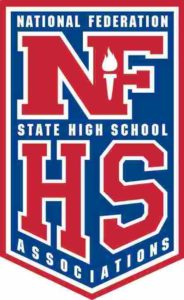HobbsDailyReport.com
 INDIANAPOLIS, Ind. – A list of significant rule changes for the 2017 high school football season adopted by the National Federation of State High School Associations (NFSHSA):
INDIANAPOLIS, Ind. – A list of significant rule changes for the 2017 high school football season adopted by the National Federation of State High School Associations (NFSHSA):
2017 POINTS OF EMPHASIS
Responsibility on Players to Avoid Illegal Contact
Illegal Helmet Contact
Sideline Management and Control, Professional Communication Between Coaches and Game Officials
Proper Enforcement of Penalties for Violations of the Equipment Rules
NO ADS ON THE BALL
Added that commercial advertising is not permitted on the ball. Rationale: The ball can’t have commercial advertising added to the surface. The only permissible items on the ball are the ball manufacturer’s name and/or logo; school name, logo and/or mascot; conference name and/or logo; state association name and/or logos; and NFHS name and/or logos.
REMEMBER, DARK UNI AT HOME
Further clarifies that the jersey of the home team shall be a dark color clearly contrasting to the white jersey required for the visiting team. Rationale: Home game jersey specifications were further revised to provide schools and manufacturers additional clarification regarding the current trend of utilizing lighter gray shades. The implementation date of 2021 affords schools and manufacturers the opportunity to ensure that newer dark-colored jerseys will clearly contrast with white jerseys. The requirement for contrasting colors to white is not a new rule, and this new clarification will allow changes to be made during normal replacement cycles.
YOU CAN COME TOO
This change now permits any of the game officials to accompany the referee to meet with the head coach for equipment verification. Rationale: Member state associations may determine the game official who is to accompany the referee during the required pre-game meeting with each head coach.
WHAT’S NOW A BLINDESIDE BLOCK?
Added a new definition for a blindside block and specifies a penalty for an illegal blindside block. Rationale: Continuing with the focus on risk minimization, the committee created a definition for a blindside block. This block involves contact by a blocker against an opponent who, because of physical positioning and focus of concentration, is vulnerable to injury. Unless initiated with open hands, it is a foul for excessive and unnecessary contact when the block is forceful and outside of the free-blocking zone.
HEY, WHAT’S A POP-UP KICK?
Added a new definition for a pop-up kick and specifies a penalty for a pop-up kick. Rationale: Continuing with the committee’s efforts to minimize risk, a pop-up kickoff has been defined. A pop-up kick is a free kick in which the kicker drives the ball immediately to the ground, the ball strikes the ground once and goes into the air in the manner of a ball kicked directly off the tee. Such kicks will be penalized as a dead-ball free-kick infraction.
A DEFENSELESS PLAYER
Expands the definition of a defenseless player by incorporating specific examples. Rationale: The committee adopted specific examples of a defenseless player. By adding these examples, the committee continues to focus on risk minimization and responded to requests on the annual NFHS football rules questionnaire from participating coaches, game officials and state association representatives.
WHEN TO START THE CLOCK
Added a new option to the offended team to start the clock on the snap for an accepted penalty inside the last two minutes of either half. Rationale: The committee added an option for the offended team on an accepted penalty inside the last two minutes of either half. The referee continues to have the authority to start or stop the clock if a team attempts to conserve or consume time illegally.
AH, IF YA LOSE A LEG….
Specifies that the ball is declared dead if a prosthetic limb comes completely off the runner. Rationale: With this change, the ball becomes dead when a prosthetic limb comes completely off the runner.
STOP TOUCHING ME
Now stipulates that it is encroachment to strike the ball or the snapper’s hand/arm prior to the snapper releasing the ball. Rationale: Defensive players are restricted from contacting the ball or the snapper’s hand(s) or arm(s) until the snapper has released the ball.
HANDS IN THE FACE NOT A PENALTY
Removes non-contact face guarding from the pass interference restrictions. Rationale: This change eliminates the previous foul for non-contact face guarding forward-pass interference.
